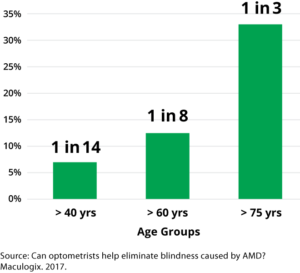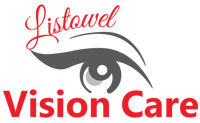What is age-related macular degeneration (AMD)?
The macula is the central most part of the retina and is responsible for detailed central vision, used when reading and recognizing people’s faces. The retina is the inner layer at the back of the eye which is sensitive to light. Macular degeneration is a condition that causes the center of your vision to blur while the side or peripheral vision remains unaffected. It is generally related to aging, which is why it is also commonly referred to as age-related macular degeneration (AMD). AMD is the leading cause of blindness in North America in adults over the age of 55.
What are the symptoms of AMD?
In the earliest stages, macular degeneration is entirely symptom free but can be detected during routine eye health examinations. The most common initial symptom is slightly blurred central vision when performing tasks that require seeing detail. Glasses cannot correct this blurred spot or sense that there is an obstruction in the way of clear vision. Over time, the blurred area may increase in size and interfere with reading and recognizing faces. Other symptoms of AMD can cause straight lines to look wavy or distorted, and dark spots may blank out portions of the central vision. Patients experience no pain with AMD and there are no signs that can be seen by a casual observer.
Are there different forms?
There are two types of AMD: dry and wet. The most common is the dry form. In the early stages, this is the milder form where there is a gradual degeneration of the central retinal tissues that make up the macula. Symptoms generally develop slowly over time, but at very old age, vision loss can eventually be greater with this type. The wet form involves a sudden leakage, or bleeding, from new, weak blood vessels under the macula. Symptoms of dry AMD progress rapidly. Wet AMD accounts for approximately 10 per cent of all cases, but the dry form can develop into the wet form over time. Any sudden change in vision should be assessed by your optometrist as soon as possible.
Who is at risk of developing AMD?
The risk of developing AMD increases with age. High-risk groups include smokers and people who have had extensive UV exposure. AMD is also associated with conditions such as high blood pressure, arteriosclerosis, obesity and those with a family history of AMD. Individuals with diets high in fat, cholesterol and sugar, and low in antioxidants are more likely to be affected by age-related macular degeneration. Light eye colour has also been linked to an increased risk of developing AMD.
How can I prevent AMD?
Lifelong UV protection and good nutrition are believed to play a key role in preventing AMD. Living a healthy lifestyle by keeping your blood pressure down, reducing your intake of fatty foods and not smoking are all recommended. A diet high in antioxidants such as beta-carotene (a form of vitamin A), vitamins C and E, zinc, lutein, zeaxanthin, selenium and omega 3 fatty acids may help prevent AMD. Most of these antioxidants are found in green leafy vegetables, yellow and orange fruit, fish, and whole grains. Regular eye examinations by an optometrist are also important in the early detection of AMD. Early signs of AMD may be found during an eye examination even if no symptoms are noticed. Your optometrist can discuss ways to minimize the possibility of vision loss due to AMD.
Is there treatment for age-related macular degeneration?
Lifestyle modifications in earlier life, such as sunglasses to reduce UV radiation and smoking cessation, may help to prevent AMD. Currently, the progression of certain stages of dry AMD is slowed with ocular vitamin supplementation. The use of vitamins will not reverse any vision loss that has already occurred, nor will it stop the progression of AMD completely. The progression of many cases of wet AMD can be prevented with medications injected into the eye to stop leaking blood vessels. Early detection and prompt intervention are crucial to addressing wet AMD. Regular eye examinations and counselling from your optometrist will let you know what treatments or preventions are best for you and when new treatments become available.
Is there help available?
Your optometrist may train you to use an Amsler grid at home, which is a sensitive tool that can alert you to the progression of AMD. It is important to contact your optometrist if you notice any changes in your central vision. Many patients with sight loss due to AMD can benefit from low vision devices. Your optometrist can prescribe magnifying devices to enhance both distance and reading vision. Higher levels of lighting and increased contrast can also help and your optometrist can advise about this also. Nowadays, there are many accessibility options on electronic devices (computers, tablets, cell phones) which are helpful. These devices and strategies will not restore sight to normal levels, but they allow people to maximize their remaining vision. If loss of vision does progress more, there are optometrists and clinics which specialize in full low vision rehabilitation.
HOW WE HELP
 We determine the type & severity of your AMD – Macular degeneration has two types: dry (atrophic) macular degeneration and wet (exudative) macular degeneration. During our comprehensive eye exam we will assess your age-related macular degeneration. We also determine the severity of the disease. Staying on top of its development allows us to better predict and manage its effects.
We determine the type & severity of your AMD – Macular degeneration has two types: dry (atrophic) macular degeneration and wet (exudative) macular degeneration. During our comprehensive eye exam we will assess your age-related macular degeneration. We also determine the severity of the disease. Staying on top of its development allows us to better predict and manage its effects.
We help you minimize & manage vision loss – Through corrective lenses, laser surgery, and using other assistive devices, we can help you compensate for the changes to your vision that AMD causes. Our Optometrists and eye care team work to improve our patient’s quality of life in every way we can.
Source:
“Age-related macular degeneration” Ontario Association of Optometrists, Retrieved 13 June 2019. <https://www.optom.on.ca/OAO/Patients/Library/Age-related_macular_degeneration.aspx>

